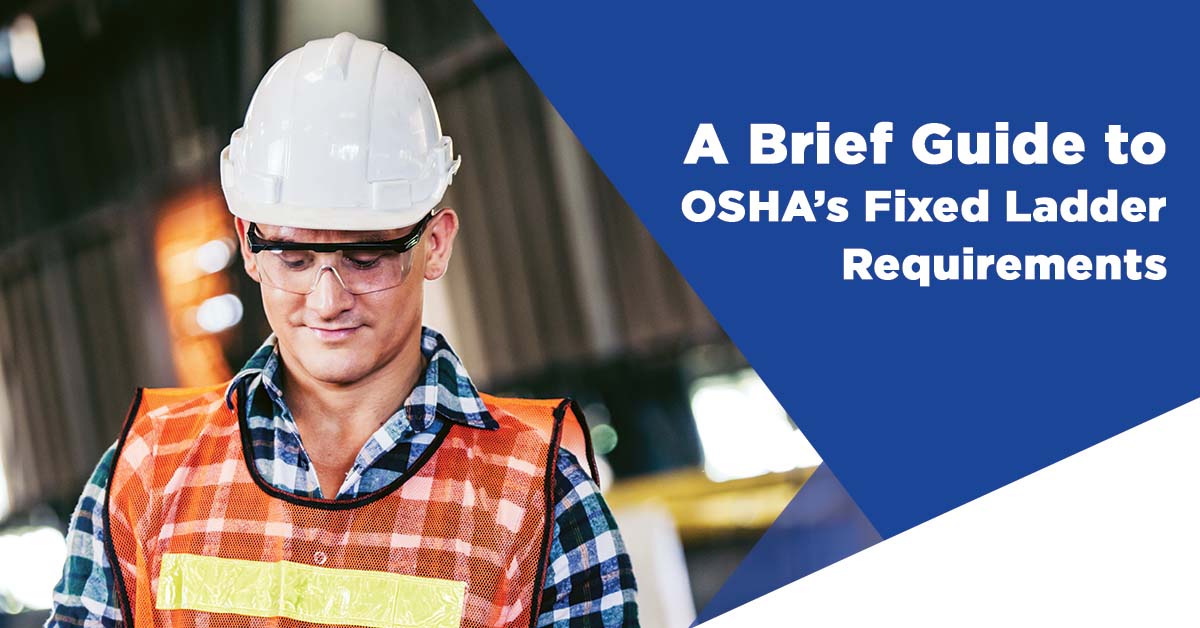A Brief Guide to OSHA’s Fixed Ladder Requirements
According to the World Health Organization (WHO), “falls are the second leading cause of unintentional injury deaths worldwide.” To prevent individuals from fatal falls, WHO recommends that risk reduction entail safety education and training, creating safer environments, and establishing effective workplace policies.
Workers, especially those who have high-risk occupations, are more prone to falls. These employees access high areas or descend manholes. All employees are entitled to safe working conditions; therefore, employers must provide top-notch equipment and implement accident prevention measures.
Fortunately, government agencies are aware of these daily hazards and have taken measures to secure the safety of millions. With the Occupational Safety and Health Act of 1970, Congress created the Occupational Safety and Health Administration (OSHA) to ensure safe and healthful working conditions for workers by setting and enforcing standards and by providing training, outreach, education and assistance.
This guide will provide an overview of OSHA’s fixed ladder requirements and why employers should comply with ladder regulations.
General Requirements for Fixed Ladders
OSHA’s ladder standards are divided into four main components: general requirements for all ladders, portable ladders, mobile ladders, and fixed ladders. In this article, we’ll focus on the important general requirements every fixed ladder should have to ensure your safety. Note that this is for reference only, and to consult with OSHA for the latest requirements.
1. Fixed ladders above 24 feet must have a fall protection system
Previously, the OSHA required fixed ladders taller than 20 feet to have cages as a form of fall protection. But, as of January 2017, OSHA changed the ladder height requirement. Fixed ladders that extend beyond 24 feet need to have fall protection systems in place.
Additionally, in 2018, the organization stated under 1910.28(b)(9) that cages were no longer considered a form of fall protection. Fixed ladders erected before November 19, 2018, will still use their existing cages. However, you must use a ladder safety system or personal fall arrest system for new or replaced ladders.
2. Applications that exceed 50 feet or above must have landing platforms
Under 1910.28(b)(9)(iii)(B), if fixed ladders with cages extend to have an unbroken length of more than 50 feet, OSHA requires that they have landing platforms in every 50-foot intervals.
3. Ladders must be made with non-corrosive material
OSHA states under 1910.23(b)(6) that metal ladders should be protected against corrosion and made with corrosion-resistant materials like aluminum. Using ladders such as high-strength and low maintenance aluminum access ladders can prevent accidents caused by residual damage or corrosion.
4. Ladder rungs should have a minimum clear width of 16 inches
Fixed ladders should have a climbing width requirement of at least 16 inches. As per OSHA 1910.23(b)(4), ladder rungs, steps, and cleats must be measured before installing ladder safety systems to ensure that they meet the given requirements. The wider the ladder system is, the easier and safer it is for you to climb it.
5. Ladders with no cages must have a clear width of at least 15 inches
If your fixed ladder doesn’t have a cage, it should be installed at least 15 inches between it and any permanent objects surrounding it. Additionally, following OSHA 1910.23(d)(13)(i), you should measure from the ladder’s centerline.
6. For fixed through ladders, side rails must provide 24 to 30 inches of clearance
The access level above the fixed ladder should at least be 24 inches wide but not more than 30 inches of clearance. As such, the ladder will be able to accommodate the width of your body, and you’ll be able to reach both side rails. In addition, according to OSHA 1910.23(d)(5), when your fixed ladder has a ladder safety system, the maximum clearance between extension handrails is 36 inches.
7. Grab bars should stick out 42 inches above the access level or landing platforms
To protect you from exiting the ladder in an access level or landing platform, grab bars should extend 42 inches above the ladder’s surface, as stated in OSHA 1910.23(d)(7). Moreover, the size of the grab bars should at least be the same as the ladder’s rungs.
8. Ladders and their nearest permanent object should have at least a 7-inch clear distance
Under OSHA 1910.23(d)(2), the minimum perpendicular distance from the centerline of the rungs to the nearest permanent object in the back of the ladder should be 7 inches. With this clearance, you’ll be able to climb the ladder without any potential trip hazards from the building.
The Importance of OSHA Compliance
Following OSHA regulations secures the continued safety of your workers. If your employees feel safe in their workplace, they are more likely to enjoy their jobs and be more productive. As such, you must make sure that both the ladder and ladder accessories you purchase are in line with the regulations stated above. For further details on fixed ladder requirements, you can review OSHA resources to learn more.
Make Ladder Safety a Priority Today
Alongside safety education and training, as an employer, you must ensure that your employees are working in a safe environment. All workplace equipment must meet regulations, especially those that are considered hazardous, such as the use of ladders to climb high places.
With O’Keeffe’s fixed ladders, safety and satisfaction are guaranteed. All our products, from access to ship ladders, are compliant with every OSHA safety regulation. Get in touch with our experts to request a quote for aluminum access ladders or ask about our custom ladder solutions.
